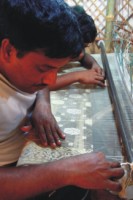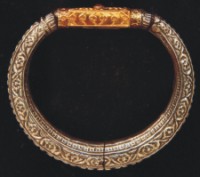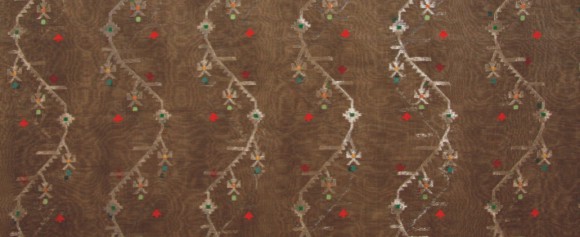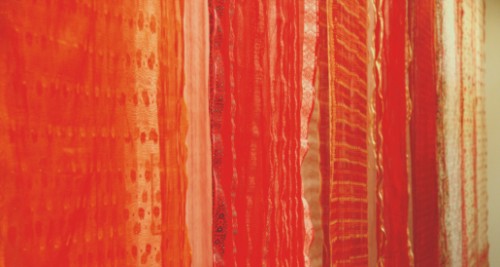Heritage
 |
A collection of old Jamdani saris have been collected and put on display. |
Celebrating the Unique
Elita Karim
 |
| Three looms have been set up at the exhibition where one
can see weavers at work. |
The art of weaving the Jamdani is indeed a unique craft, which has been in this country for many centuries. The extraordinary designs and the hand woven exclusivity of each design have placed the Jamdani in a class of its own. 'The Story of Pride', an exhibition on Jamdani saris was recently inaugurated at the Bangladesh Shilpakala Academy. As a part of Aarong's 30th anniversary, this exclusive exhibition on the Jamdani designs began on January 10 and will continue till January 20. “We have been working on this exhibition for two years and have done an enormous amount of research and documentation on old motifs which have formed the basis of the designs for the exhibition,” says Tamara Abed, Director of Arong and Ayesha Abed Foundation as well as the Exhibition Convener.
One of the big attractions of this exhibition is the section where a collection of old Jamdani saris have been collected and put on display. Some of the saris date back to the last 50 years while some date back to a couple of centuries. Many of these saris come out of Aarong's own collections, while some have been collected by individual collectors and Jamdani enthusiasts. “One of the rarest and most special pieces on display is a 200-year-old sari from Aarong's own antique collection,” says Tamara. “Some of the other old pieces have been kindly lent to us by collectors for research/display at the exhibition.” She further adds that all the saris at the exhibition are woven in 80 count thread of very high quality, which is a rarity now.
 Another attraction of the exhibition is the catalogue printed for the visitors at the exhibition. It includes rare information on the art of Jamdani and also includes the names of the various Jamdani motifs and stitches along with their pictorial representations. At the inauguration ceremony of the exhibition, Aarong awarded six Jamdani weavers, who have showcased their excellence in Jamdani weaving through the exhibition. Titled the 'Award of Excellence' in Jamdani weaving, prize money of Tk 50,000, Tk 30,000 and Tk 20,000 were awarded to Karigar (master weaver) Md Motalib and his apprentice Shahnaz; Karigar Md Osman and his apprentice Abeda; and Karigar Md Shobuj and his apprentice Md Jalil, respectively. Another attraction of the exhibition is the catalogue printed for the visitors at the exhibition. It includes rare information on the art of Jamdani and also includes the names of the various Jamdani motifs and stitches along with their pictorial representations. At the inauguration ceremony of the exhibition, Aarong awarded six Jamdani weavers, who have showcased their excellence in Jamdani weaving through the exhibition. Titled the 'Award of Excellence' in Jamdani weaving, prize money of Tk 50,000, Tk 30,000 and Tk 20,000 were awarded to Karigar (master weaver) Md Motalib and his apprentice Shahnaz; Karigar Md Osman and his apprentice Abeda; and Karigar Md Shobuj and his apprentice Md Jalil, respectively.
The first Jamdani exhibition was organised by Aarong with the help of Brac in 1981. According to Tamara, it was decided to make the ongoing Jamdani exhibition a part of the 30 year celebrations of Aarong for three reasons. “First, it had been almost 30 years since we did the first one and no major national level Jamdani exhibition has been done on this scale since,” says Tamara. “So we thought it was high time to shine the spotlight on one of our finest and most treasured crafts. Second, the Jamdani has been a source of pride for us for hundreds of years. But today, the industry with the predicament of the weavers is far from where it needs to be. So we all need to take initiative and do our bit to promote and patronise it so that we do not lose what is left of this illustrious textile heritage of our country. Third, our Jamdani weavers are a most precious asset and people need to know and appreciate the skilful artistry and hard work that goes into making a Jamdani sari.”
 According to the article in the catalogue, "Jamdani: Reviving Our Past Pride and Looking Forward to a Future of Unlimited Possibilities" by Chandra Shekhar Shaha, the Project Consultant, Design and Product Development, Jamdani is unique for mainly two reasons - firstly, its distinctiveness in terms of design and the consistent use of geometric patterns, inspired by Iranian motifs. “Secondly, the opacity of the pattern woven into the transparent base mesh together during the weaving process in such a way as to make the Jamdani look delicate and beautiful,” he writes. He further writes that even though the motifs have an abstract look, the designs are actually the creative and geometric transformation of nature's elements such as creepers, leaves, flowers, animals and so on. To understand the way weavers work and the motifs that they weave on to the saris, three looms have been set up at the exhibition where one can see weavers at work. According to the article in the catalogue, "Jamdani: Reviving Our Past Pride and Looking Forward to a Future of Unlimited Possibilities" by Chandra Shekhar Shaha, the Project Consultant, Design and Product Development, Jamdani is unique for mainly two reasons - firstly, its distinctiveness in terms of design and the consistent use of geometric patterns, inspired by Iranian motifs. “Secondly, the opacity of the pattern woven into the transparent base mesh together during the weaving process in such a way as to make the Jamdani look delicate and beautiful,” he writes. He further writes that even though the motifs have an abstract look, the designs are actually the creative and geometric transformation of nature's elements such as creepers, leaves, flowers, animals and so on. To understand the way weavers work and the motifs that they weave on to the saris, three looms have been set up at the exhibition where one can see weavers at work.
 |
| Even though the motifs have an abstract look, the designs are actually the creative and geometric transformation of nature's elements. |
In spite of the fact that something so extraordinary and unique like Jamdani weaving exists in our country, some fear that there might come a time when the art will slowly fade away. Tamara, however, does not agree. She believes that the Jamdani -- once worn by the royals in the Mughal courts and the fabric used in dresses by the most fashionable ladies in Versailles and London in the 17th and 18th centuries -- is here to stay for centuries more. “The Jamdani industry can grow and will not fade away if we all appreciate the value of Jamdani, buy it and wear it,” she says. “We tend to buy expensive Indian or Pakistani saris but complain that Jamdani saris are too expensive. We need to understand that Jamdanis are 100 percent handmade, the motifs are woven in by hand, not in a jacquard loom (as is the case with most of the other/Indian saris, so it can be produced much faster) almost as if they are being embroidered on the loom. If we are willing to pay the right value, then the quality of the saris in terms of the yarn, the intricacy and quality of the motifs and the workmanship will not deteriorate further.”
The exhibition is open for all till January 20, 2010 - Saturdays to Thursdays from 11 am to 7 pm and Fridays from 3 pm to 7 pm.
 |
| The opacity of the pattern woven into the transparent base mesh together during the weaving process in such a way as to make the Jamdani look delicate and beautiful. |
Copyright
(R) thedailystar.net 2009 |
